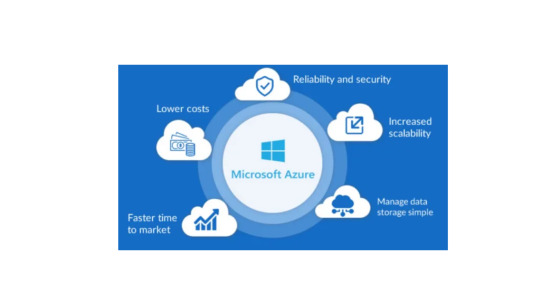#azure solutions
Explore tagged Tumblr posts
Text
0 notes
Text
Empower Your Business with Microsoft Azure Consulting Services by Goognu
Our team of highly skilled Azure consultants brings deep expertise in designing, implementing, and managing Azure solutions tailored to your unique business needs. Whether you are just starting your cloud journey or looking to optimize your existing Azure environment, we provide end-to-end consulting services that ensure a seamless and successful migration to Azure.
0 notes
Text
5 Pro Tips for SMEs to Build an Effective Cloud Computing Strategy
How is Cloud Computing Changing the Future of Work for SMEs in 2023?
Accelerated by the cloud, long-term digital transformation and modernization initiatives have gained momentum. 85% of organizations will embrace the cloud-first principle by 2025, and all their digital strategies will use cloud-native architectures and technologies.
The rise of cloud computing is revolutionizing the way businesses operate. Those organizations that have already embraced the “cloud shift” (both startups and SMEs) reportedly experienced a positive impact on operational efficiency within a few months.
In the past, businesses had to invest in their own hardware and software to run their operations. With cloud computing, access to applications and services does not require any upfront investments. Cloud resources are more affordable as the users pay for only what they use. That is more cost-effective and especially beneficial for small and medium-sized enterprises (SMEs) working with small budgets. With cloud leverage, SMEs can level the playing field and compete with larger businesses.
Global cloud computing supports access to data anytime from any part of the world. Cloud-based applications and services are more collaborative, allowing for more flexibility in how work gets done. That can lead to more productive and efficient workflows.
Cloud computing is thus changing the future of work for SMEs, optimizing operational efficiency and cost-effectiveness and thereby enabling scalability, helping SMEs build high revenue-generating businesses, faster than ever before.
5 Pro Tips for an Effective Cloud Computing Strategy
“There is no business strategy without a cloud strategy,” - Milind Govekar, Chief of Research, Program & Portfolio Management (PPM) Research, Gartner, Inc.
Tip #1 - Choose the Right Cloud Migration Services Provider
Cloud migration is the process of moving applications and data from one location—often a company's private on-premises servers—to a public cloud provider’s servers. It might also involve switching between different clouds.
While transitioning to the cloud, it's crucial to make a sound start in a planned manner for a successful migration. Identifying which applications and services need to be shifted on priority with minimal disruption time and scaling up cloud deployment as necessary. Defining the business goals and clarifying the minimum expectations will help the cloud partner, understand the business requirements better and deliver migration services efficiently.
Selecting the right cloud migration partner is as daunting a task as picking the right cloud provider can be. It's important to have a trustworthy partner who displays solid technical expertise and deep experience in effective data management, industry best practices, and compliance management.
Tip #2 - Establish a Secure and Reliable Infrastructure for a Digitally Interlinked Future
With the rapid digital transformation of businesses and the increasing number of cloud migrations, there is greater concern regarding cloud security. For safeguarding data, applications, and cloud infrastructure from cyber threats and attacks, robust cyber security is crucial.
In an evolving threat landscape, where data is money, industry insights say that the global average total cost of a data breach is $4.35M, 45% of breaches occurred in the cloud, and in 2022 it took an average of 277 days—about 9 months—to identify and contain a breach.
A cloud services provider with significant cyber security experience will provide resources and a cloud stack that ensures a secure environment several magnitudes higher than the average small to medium enterprise can setup on premise. Cloud service providers have, security integrated into every layer, built-in mechanisms to protect against distributed denial-of-service (DDoS) attacks, and features that allow for data encryption when at rest, as well as in transit.
Responsible cloud partners, take proactive steps for infrastructure management and data asset security by integrating appropriate controls, procedures, and best practices; also ensuring businesses remain compliant with data privacy laws.
Tip #3 - Utilize Modernization Strategies for Increasing Scalability and Decreasing Cloud Spend
Modernization with cloud computing typically means the migration of legacy or traditional applications to cloud environments such as public cloud platforms, private clouds, etc.
Outdated tech stacks will eventually cause a degradation in customer engagement and user experience. However, retiring or replacing legacy software systems often translates into heavy financial and productivity losses, aside from other issues. Therefore, upgrading or rearchitecting the existing software on on-premises solutions and moving to the cloud have proven more feasible and beneficial for most SMEs.
Every modernization project must have a well-articulated strategy to minimize risks and disruption in overall business performance. The right cloud partner will get a thorough understanding of business objectives and advocate appropriate tools and technologies for re-architecting legacy applications.
Effective cloud engineering for application modernization can reduce infrastructure costs as businesses no longer need to spend on manual adjustments and maintenance. It provides access to unlimited data storage space in the cloud, allowing need-based space usage for business expansion. Thus, businesses with cloud infrastructure become more scalable and time & cost-efficient.
Tip #4- Focus on Quality Assurance & Testing
Cloud-based quality assurance (QA) and software testing are rapidly replacing on-premise QA because of the process agility, cost efficiency, and easy access to a wide pool of resources.
Cloud computing enables continuous monitoring of applications and data-based problem detection. Cloud quality assurance systems help businesses troubleshoot performance bottlenecks and prevent defects while delivering products or services. Quality testing and scaling up applications in the cloud support performance optimization in terms of both functionality and stability.
Tip #5- Ensure Business Continuity with Disaster Recovery Plan
All small and medium-sized enterprises need to enable business continuity management and ensure thorough disaster recovery plans are in place.
Cloud computing Disaster Recovery as a Service (DRaaS) allows businesses to regain access to the IT infrastructure and back up data in a cloud environment safely from anywhere in the world and at any time in the event of man-made or natural disasters.
Disaster Recovery orchestration provides standby computing capacity on demand to run applications with minimal operational downtime. Effective rapid recovery planning will prevent inefficiencies in system functioning, ensuring the business keeps running without abnormalities despite disastrous events.
Having a skilled technical team to analyze and seamlessly resolve problems during incidents, implement fixes, and design long-term solutions systematically is crucial.
Programmability & Customization – Creating Unique Solutions with Maximum Efficiency
The rise of cloud computing has widened the horizons for SMEs. Businesses can now get custom-designed software solutions specific to their needs and goals with—cost, time, and resource— efficiency for optimal productivity.
With cloud leverage for programmability and customization, businesses can create unique products or services that will surely lead them toward achieving customer success.
MetaSys, a leading custom software outsourcing firm in India, has Microsoft-certified Azure solutions architects who can help businesses construct a cloud infrastructure, integrate the cloud with their current infrastructure, and manage the whole migration to Azure.
Some key advantages of cloud computing with Microsoft Azure are reliability, rapid disaster recovery, reduced capital expenditures (CapEx), and impressive scalability and elasticity.
Get Ready for the Future of Work.
0 notes
Text








Even with the smallest amount of attention from Estinien, she just melts. ♡
#final fantasy xiv#ffxiv#final fantasy 14#ff14#ffxiv screenshots#ffxiv gpose#ffxiv oc#marian varlineau#estinien varlineau#ffxiv au#ffxiv dragoon#ffxiv scholar#solution nine#ffxiv solution nine#ffxiv au ra#ffxiv elezen#wolship#wolstinien#date night#azure flame#scaled bright star
19 notes
·
View notes
Text

Is Z13 playing or watching a YouTuber play Lethal Company??? XD
Azur Lane getting very creative and referencing in these new Juustagrams.
2 notes
·
View notes
Text
Simplify Transactions and Boost Efficiency with Our Cash Collection Application
Manual cash collection can lead to inefficiencies and increased risks for businesses. Our cash collection application provides a streamlined solution, tailored to support all business sizes in managing cash effortlessly. Key features include automated invoicing, multi-channel payment options, and comprehensive analytics, all of which simplify the payment process and enhance transparency. The application is designed with a focus on usability and security, ensuring that every transaction is traceable and error-free. With real-time insights and customizable settings, you can adapt the application to align with your business needs. Its robust reporting functions give you a bird’s eye view of financial performance, helping you make data-driven decisions. Move beyond traditional, error-prone cash handling methods and step into the future with a digital approach. With our cash collection application, optimize cash flow and enjoy better financial control at every level of your organization.
#seo agency#seo company#seo marketing#digital marketing#seo services#azure cloud services#amazon web services#ai powered application#android app development#augmented reality solutions#augmented reality in education#augmented reality (ar)#augmented reality agency#augmented reality development services#cash collection application#cloud security services#iot applications#iot#iotsolutions#iot development services#iot platform#digitaltransformation#innovation#techinnovation#iot app development services#large language model services#artificial intelligence#llm#generative ai#ai
4 notes
·
View notes
Text
Secure Your Digital Assets with Reliable WordPress Security Services
A secure website is the cornerstone of a successful online presence. Atcuality provides unparalleled WordPress security services to shield your site from cybercriminals and data breaches. Our comprehensive approach includes regular vulnerability scans, plugin and theme updates, and advanced encryption protocols to secure your sensitive information. Whether it's mitigating DDoS attacks or strengthening login security, we employ the latest tools and technologies to keep your WordPress site secure. Trust Atcuality to deliver peace of mind with a secure and seamless online experience.
#ai powered application#ai applications#amazon web services#mobile application development#app development company#mobile app development company#mobile app development#mobile app developers#app design and development#app development#web app development#augmented reality#metaverse#virtual reality#azure cloud services#custom app development#blockchain#cash collection application#cloud security services#cloud security solutions#cloud computing#cloud#custom wordpress development services#wordpress development#web development#website design#web developers#web design#ecommerce website development#digital marketing
1 note
·
View note
Text
Azure IoT Central: Revolutionizing IoT Solutions for Manufacturing Industries
Azure IoT Central is a cutting-edge platform built on the foundation of Azure IoT, offering a model-based approach to empower businesses in constructing enterprise-grade IoT solutions. Designed with the aim of eliminating the need for cloud-solution development expertise, Azure IoT Central provides a comprehensive software as a service (SaaS) solution. With its built-in templates for various industries, device provisioning services, and feature-rich dashboards, it enables seamless monitoring of device health, connectivity, management, and communication.

Streamlining Manufacturing Operations with Azure IoT Central
In the realm of manufacturing, Azure IoT Central proves to be a game-changer by facilitating the seamless connection, management, and monitoring of industrial assets. By leveraging Azure IoT Central, manufacturing industries can effortlessly integrate data into their applications, enabling them to make data-driven decisions and unlock operational efficiencies. With its user-friendly interface and powerful capabilities, Azure IoT Central empowers manufacturers to gain valuable insights from their assets and drive productivity.
Key Features and Benefits
Template-based Solution: Azure IoT Central offers pre-built templates tailored for various industries, enabling businesses to quickly deploy IoT solutions without extensive customization. These templates encompass a wide range of applications, including asset tracking, predictive maintenance, and remote monitoring, among others.
Device Provisioning Services: Simplifying the process of onboarding devices, Azure IoT Central provides robust device provisioning services. This feature streamlines the connection and configuration of devices, ensuring seamless integration into the IoT ecosystem.
Comprehensive Dashboard: Azure IoT Central's intuitive dashboard empowers businesses to monitor and manage their IoT devices effectively. From tracking device health and connectivity to managing firmware updates and troubleshooting, the dashboard provides real-time insights and facilitates proactive maintenance.
Secure and Scalable: Built on the trusted Azure IoT platform, Azure IoT Central ensures top-notch security for sensitive data and device communications. Moreover, it offers scalability to accommodate growing business needs, allowing seamless expansion without compromising performance.
Integration Capabilities: Azure IoT Central seamlessly integrates with other Azure services, such as Azure Machine Learning and Azure Stream Analytics, enabling advanced analytics, machine learning capabilities, and seamless data integration across the Azure ecosystem.
Unlocking the Potential of IoT in Manufacturing
By harnessing the power of Azure IoT Central, manufacturing industries can revolutionize their operations and tap into the full potential of IoT. Here's how Azure IoT Central can benefit manufacturing businesses:
Enhanced Operational Efficiency: Real-time monitoring and analysis of industrial assets enable proactive maintenance, minimizing downtime and optimizing operations. Predictive maintenance and condition monitoring enable businesses to identify and address potential issues before they escalate.
Improved Product Quality: IoT-enabled sensors and devices collect data throughout the production process, ensuring quality control and adherence to standards. Businesses can gain valuable insights into product performance, identify defects, and take corrective measures promptly.
Cost Optimization: By leveraging Azure IoT Central, manufacturers can optimize resource allocation, reduce energy consumption, and streamline maintenance processes. Data-driven insights enable businesses to make informed decisions, resulting in cost savings and improved profitability.
Enhanced Safety and Compliance: IoT devices and sensors can monitor environmental conditions, ensuring a safe working environment for employees. Moreover, businesses can leverage IoT data to comply with industry regulations and maintain quality standards.
Get Started with Azure IoT Central Today
Take the first step toward transforming your manufacturing operations with Azure IoT Central. Leverage its advanced features, comprehensive templates, and user-friendly interface to build robust IoT solutions that propel your business forward. Embrace the power of data, streamline your operations, and unlock unparalleled insights with Azure IoT Central.
#Azure IoT Central#IoT solutions#Azure IoT solutions#Azure IoT cloud services#Azure IoT application development#Azure IoT cloud integration#Azure IoT analytics
2 notes
·
View notes
Text
Product Designer
Job title: Product Designer Company: Betway Job description: testing. Knowledge of industry trends and emerging technologies in UX/UI design. Problem-solving and critical-thinking… will help us achieve our vision. As a Product designer you understand user and business needs and pain points through research… Expected salary: Location: Camden Town, North West London Job date: Sat, 28 Jun 2025…
#5G#artificial intelligence#Azure#Blockchain#Crypto#data-privacy#data-science#Ecommerce#edtech#erp#fintech#Frontend#insurtech#iOS#marine-tech#mobile-development#no-code#prompt-engineering#proptech#qa-testing#remote-jobs#robotics#scrum#SEO#solutions-architecture#system-administration#technical-writing#UX/UI Designer#visa-sponsorship
0 notes
Text
From Migration to Optimization: How Azure Partners Streamline Cloud Journeys

In today’s fast-paced digital era, cloud adoption is no longer a question of “if,” but “how fast.” For businesses eager to innovate, scale, and stay competitive, Microsoft Azure stands out as a powerful and flexible cloud platform. But it takes more than a lift-and-shift strategy to realize its full potential. That’s where Microsoft Azure partners come in—bringing expertise, strategy, and hands-on support to streamline your entire cloud journey, from migration to continuous optimization.
Whether you're moving your first workload to the cloud or fine-tuning an already running Azure environment, certified Azure partners act as your trusted navigators, ensuring your journey is smooth, secure, and cost-effective.
What Are Azure Partners?
Azure partners are certified organizations or cybersecurity consulting firms authorized by Microsoft to help businesses design, deploy, manage, and optimize Azure cloud solutions. These partners go through rigorous training and accreditation to ensure they meet Microsoft’s high standards.
They specialize in various areas such as:
Azure Cloud migration
Infrastructure modernization
Data and AI
Application development
Security and compliance
Cost management and optimization
In short, Azure partners are like experienced guides who help you climb the mountain of cloud transformation—safely and efficiently.
Why Businesses Choose Azure for Cloud Transformation
Before diving into the role of Azure partners, let’s understand why so many businesses are embracing Azure:
Scalability: The capacity to swiftly modify resources to satisfy demand.
Security: Azure has over 90 compliance certifications and built-in threat detection.
Hybrid Capabilities: Seamless integration with on-premises data centers using Azure Arc.
Advanced Services: AI, machine learning, analytics, and IoT capabilities.
Global Reach: Data centers in more than 60 regions worldwide.
But as powerful as Azure is, navigating it without expert help can be overwhelming. That’s where Azure partners become invaluable.
Phase 1: Planning & Assessment
Understanding Business Goals
Azure partners begin by deeply understanding your business goals, IT landscape, and compliance needs. They assess your current infrastructure, applications, workloads, and pain points to determine if Azure is the right fit and how best to approach the migration.
Cloud Readiness Assessment
A thorough evaluation determines which workloads are appropriate for transfer, as well as any possible dangers, financial consequences, and performance goals. This phase ensures you're making informed decisions and not rushing into migration blindly.
Developing a Roadmap
Based on the assessment, the Azure partner creates a custom roadmap outlining:
Migration timeline
Tools and methodologies
Cost estimates
Resource allocation
Compliance requirements
Phase 2: Cloud Migration
Lift-and-Shift or Re-Architecting
Azure partners determine the best migration strategy for each workload:
Lift-and-shift for faster migration of legacy apps.
Re-platforming to take advantage of PaaS features.
Re-architecting for scalability, performance, and long-term efficiency.
Utilizing Azure Migration Tools
Certified partners leverage Microsoft’s native tools, such as:
Azure Migrate
Azure Site Recovery
Database Migration Service
These tools help reduce downtime, minimize data loss, and ensure smoother transitions.
Ensuring Business Continuity
During migration, Azure partners monitor systems closely to ensure minimal disruption. Backup and disaster recovery solutions are also configured to keep operations running smoothly.
Phase 3: Post-Migration Support
Validation and Testing
After the migration is finished, careful verification makes sure everything functions as it should:
Application functionality
Data integrity
Performance benchmarks
Security configurations
Azure partners troubleshoot any post-migration issues and tweak configurations for optimal performance.
User Training and Change Management
Migration is not just technical—it’s cultural too. Azure partners help with user training, documentation, and support to ensure your team embraces the new environment with confidence.
Phase 4: Continuous Optimization
Migration is only half the story. The real value of cloud transformation lies in continuous optimization, and this is where Azure partners truly shine.
Performance Tuning
Partners analyze workload behavior, monitor performance metrics, and make necessary adjustments to improve speed, responsiveness, and reliability.
Cost Optimization
By rightsizing resources, automating scaling, and eliminating unused services, Azure partners help reduce cloud costs significantly. They also advise on using Azure Reserved Instances and Azure Cost Management to gain better financial control.
Security Enhancements
With ever-evolving cyber threats, continuous security monitoring is essential. Azure partners help:
Set up firewalls and threat protection
Configure role-based access controls
Monitor compliance with regulations like GDPR or HIPAA
Conduct regular security audits
Innovation Enablement
Azure isn’t just a hosting platform—it’s a launchpad for innovation. Certified partners help you:
Deploy AI and machine learning models
Use analytics for smarter business insights
Build modern applications using containers and microservices
Benefits of Working with Azure Partners
Faster Time to Value: Avoid trial and error with proven methodologies.
Expertise on Demand: Access skilled professionals without hiring internally.
Scalable Solutions: Grow your cloud environment as your business grows.
Reduced Downtime: Minimize disruptions with proactive planning and monitoring.
Innovation Acceleration: Leverage cutting-edge Azure cloud services effectively.
How to Choose the Right Azure Partner
Not all partners are created equal. Here’s what to look for:
Microsoft Gold or Solutions Partner Status
Industry-specific experience
Certified Azure engineers
Successful case studies and references
Managed service offerings
24/7 support and SLAs
Choosing the right partner is a strategic decision. They’re not just vendors—they’re collaborators in your digital transformation journey.
The Future of Cloud: Beyond Migration
The cloud isn’t a destination—it’s a continuous journey. Azure’s ecosystem is expanding rapidly, offering innovations in areas like:
Quantum computing
Mixed reality
Green cloud solutions
Industry-specific cloud modules (e.g., Azure for Healthcare, Azure for Retail)
To keep pace, businesses must evolve constantly, and Azure partners provide the guidance, tools, and strategy to do exactly that.
Conclusion
Azure partners are essential to a successful cloud transition, from early planning and migration to continuous optimization and innovation. They remove the complexity of the Azure platform, enabling your business to focus on growth, agility, and customer value.
Whether you’re starting your cloud journey or looking to get more from your existing Azure setup, working with a certified Azure partner ensures you get the best results, faster and with less risk.
Cloud isn’t just about moving workloads—it’s about unlocking potential. With the right partner, Azure becomes not just a platform but a business advantage.
FAQs
1. What’s the difference between an Azure partner and a managed service provider?
Azure partners offer specialized expertise in designing and optimizing Azure environments. Managed cloud service providers may handle day-to-day maintenance, but don’t always specialize in Azure.
2. Is working with an Azure partner expensive?
While there’s a cost involved, the ROI is typically high due to faster migrations, reduced downtime, and optimized resource usage, saving money long-term.
3. Can Azure partners help with hybrid environments?
Yes, many partners specialize in hybrid solutions, helping you connect on-premise systems with Azure cloud using services like Azure Arc.
4. How long does an Azure migration typically take?
It varies depending on the complexity of your workloads, but with the help of an Azure partner, many projects can be completed within a few weeks to a few months.
5. Are Azure partners only for large enterprises?
Not at all. Azure partners work with businesses of all sizes—from startups to Fortune 500 companies—offering scalable services to match your needs.
#cloud governance#cloud risk management framework#Azure Security Center#aws configuration#Azure Compliance Manager#Azure Information Protection#aws key management service#GRC solutions
0 notes
Text

Microsoft Azure in 2025: Innovations Shaping the Future of Cloud Computing
As we enter 2025, Microsoft Azure remains on the forefront of the cloud computing revolution. Azure transforms the arena of business operation and management of data and scale with its all-inclusive ecosystem, innovative services and enterprise-centered solutions.
#microsoft azure in uae#azure reseller uae#azure cloud solution in uae#azure reseller dubai#microsoft azure
0 notes
Text
Transforming Business Efficiency with Azure Cloud Solutions
Cloud computing stands as a cornerstone for organizational innovation and efficiency. Among various platforms, Azure has emerged prominently, offering businesses robust cloud infrastructure and intelligent solutions. Collaborating with a reputable azure cloud solution provider enables enterprises to maximize these offerings effectively, facilitating seamless digital transformation.
Azure’s extensive global reach and seamless integration capabilities ensure businesses can operate smoothly across multiple geographic locations, creating a unified infrastructure for global operations. This connectivity not only promotes collaboration but also significantly enhances customer experiences and market responsiveness.
Why Businesses Choose Azure Cloud Solutions
Azure provides an expansive suite of cloud services designed to meet diverse organizational needs. Its comprehensive infrastructure supports everything from virtual computing and databases to analytics, artificial intelligence, and Internet of Things (IoT). Companies leveraging Azure’s services significantly streamline operations and enhance productivity, thus gaining a competitive edge in their respective industries.
Scalability and Flexibility
Azure’s flexible infrastructure allows organizations to scale resources dynamically, aligning with changing business demands. Whether managing workload spikes during peak seasons or downsizing in slower periods, Azure adjusts swiftly, optimizing costs and operational efficiency.
Robust Security Framework
Security remains paramount when selecting cloud solutions. Azure incorporates rigorous security protocols, including identity and access management, threat detection, and advanced encryption standards. Businesses partnering with a trusted azure cloud solution provider benefit from fortified data protection and compliance adherence, mitigating cybersecurity risks substantially.
High Availability and Reliability
Azure guarantees unparalleled availability and reliability, significantly reducing downtime. Its geographically dispersed data centers ensure uninterrupted service delivery and disaster recovery, protecting critical business data and applications against unforeseen events.
Key Services Offered by Azure Cloud
Azure Virtual Machines
Azure Virtual Machines provide scalable computing power that supports diverse business applications. Enterprises efficiently deploy applications without the constraints of traditional hardware limitations, reducing initial capital investment while accelerating innovation.
Azure App Service
Azure App Service simplifies web and mobile app deployment, delivering high-performance and scalable applications rapidly. Its integrated features streamline development and deployment cycles, promoting quicker market entry and continuous enhancement.
Azure Analytics and AI
Azure’s analytics and artificial intelligence capabilities allow organizations to extract actionable insights from extensive data sets. Tools like Azure Machine Learning, Cognitive Services, and Data Factory empower businesses to make informed, strategic decisions based on real-time data analytics.
Azure IoT Suite
The Azure IoT Suite provides comprehensive solutions for connecting, managing, and analyzing IoT devices securely. By integrating IoT technology, enterprises achieve improved operational efficiency, predictive maintenance, and enhanced customer experiences.
Selecting the Right Azure Cloud Solution Provider
Choosing an appropriate azure cloud solution provider significantly influences an organization’s success with cloud migration and management. Here are key considerations when selecting your Azure partner:
Proven Expertise and Experience
Ensure your chosen provider has demonstrable experience and certified expertise in Azure deployment and management. Experienced providers offer strategic insights, best practices, and smooth transition paths, minimizing potential disruptions.
Comprehensive Support and Management
Evaluate providers based on their capability to deliver comprehensive support throughout the cloud lifecycle. Effective management includes migration, configuration, ongoing monitoring, optimization, and proactive issue resolution, allowing organizations to focus on core business operations.
Customized Solutions
Every business has unique operational requirements. Opt for providers who offer tailored Azure cloud solutions that specifically address individual business needs and objectives. Customized approaches result in higher efficiency and better alignment with organizational goals.
Cost Efficiency
An ideal Azure partner assists in optimizing cloud expenses through proactive management and precise resource allocation. Providers who emphasize cost-effective practices ensure clients gain maximum value from their cloud investment without sacrificing performance.
Case Studies
Companies across various sectors, from healthcare to finance and manufacturing, have experienced significant transformations with Azure cloud implementations. For instance, healthcare providers using Azure securely manage patient data, streamline operational processes, and improve patient care through real-time analytics. Financial institutions enhance risk management, security, and transaction efficiency, leveraging Azure’s advanced data processing capabilities.
Overcoming Challenges in Azure Migration
Migrating to the cloud presents certain challenges, including data security concerns, migration complexities, and organizational change management. Partnering with an adept Azure provider addresses these challenges effectively through meticulous planning, security protocols, and comprehensive support, facilitating a smoother transition.
Conclusion
Adopting Azure cloud solutions through collaboration with an experienced azure cloud solution provider positions organizations strategically for future growth and sustainability. Azure’s robust, secure, and scalable offerings enable businesses to meet evolving market demands proactively. With the right partner, Azure cloud integration transforms organizational capabilities, driving innovation, agility, and lasting competitive advantages.
As businesses navigate increasing digital complexities, investing in Azure cloud solutions not only streamlines internal processes but also positions companies at the forefront of technological innovation. A strategic Azure implementation fosters long-term resilience and prepares businesses for emerging opportunities and challenges alike.
0 notes
Text
Focus on Your Business: Let Professional IT Services Handle Your Technology Department
For any business to succeed today, its technology infrastructure must be dependable and always operate optimally. Communication, handling data, cybersecurity, and new solutions rely on technology to function in today's world. At the same time, many SMEs find it too costly and demanding to maintain and build an effective IT team within the company. Joining up with expert IT specialists is especially beneficial here, as you are free to focus on essential factors while IT professionals handle everything computer-related. Source URL: https://virtualvivienne.com/focus-on-your-business-let-professional-it-services-handle-your-technology-department/
#managed it services#it services#microsoft 365 consulting#cloud solutions#data backup & ransomware protection#it support#amazon aws consulting#google workspace consulting#it consulting#microsoft azure consulting
0 notes
Text
#Cloud Computing#Cloud Servers#Disaster Recovery#Virtual Private Server#Multi-Cloud#AWS#Microsoft Azure#Cloud Security#Hosting Solutions
0 notes
Text
Microsoft GCC Substantial Expert Services: Secure Answers for presidency and Protection
Within an era the place cybersecurity threats are going up, businesses dealing with sensitive government data will need strong alternatives to be certain compliance and security. Microsoft GCC (Government Group Cloud) Substantial offers specialised providers personalized to meet the rigorous prerequisites of U.S. authorities businesses, protection contractors, along with other organizations handling Controlled Unclassified Information (CUI). In this post, we delve into your key functions, benefits, and very best tactics of Microsoft GCC Significant Products and services.
What on earth is Microsoft GCC Higher?
Microsoft GCC Significant is actually a protected, compliant cloud platform created to help the exclusive requirements of organizations working with delicate details governed by federal regulations. It offers a protected environment for storing, processing, and transmitting info, adhering to expectations like:
FedRAMP Significant: Federal Hazard and Authorization Management Method certification for high-affect facts.
ITAR Compliance: Assures compliance with the Intercontinental Visitors in Arms Rules.
DFARS/NIST 800-171: Supports compliance With all the Protection Federal Acquisition Regulation Health supplement as well as the National Institute of Expectations and Know-how benchmarks.
youtube
Important Functions of Microsoft GCC Substantial Providers
Improved Security
Multi-aspect authentication (MFA)
Highly developed Menace Defense (ATP)
Encrypted facts storage and transmission
Compliance Resources
Constructed-in tools for monitoring and keeping compliance with federal standards.
Audit logging and security event monitoring.
Isolated Natural environment
Focused infrastructure divided from business environments.
Restricted use of licensed personnel only.
Collaboration and Conversation
Safe variations of Microsoft Teams, SharePoint, and Trade On line tailored for CUI and sensitive information.
Great things about Microsoft GCC Significant
Regulatory Compliance: Will help organizations fulfill stringent govt and defense knowledge requirements.
Sturdy Protection: Delivers assurance with Innovative cybersecurity steps.
Productivity Equipment: Enables seamless collaboration even though maintaining compliance.
Scalability: Delivers adaptability to scale services as organizational wants improve.
Who Need to Use Microsoft GCC Large?
Microsoft GCC Substantial is perfect for:
U.S. federal organizations
Protection contractors
Aerospace organizations
Organizations dealing with CUI beneath DFARS or ITAR laws
Ideal Techniques for Employing GCC High
Understand Your Compliance Desires
Conduct an intensive evaluation of one's Corporation's compliance prerequisites.
Lover with Licensed Professionals
Perform with Microsoft associates expert in GCC Substantial deployment to be sure easy implementation.
Practice Your Team
Teach personnel on the correct usage of GCC Substantial resources and compliance protocols.
Monitor and Update
Routinely review protection options and compliance configurations to adapt to evolving threats and needs.
Summary Microsoft GCC High Companies offer a dependable Answer for companies managing sensitive governing administration info. By making sure strong security, regulatory compliance, and productive collaboration, GCC Significant empowers corporations to fulfill their distinctive issues confidently. For more info or to start your GCC Significant journey, connect with a certified Microsoft partner right now.
Get more info. here: GCC High Compliance Consulting
#Microsoft GCC High Services#GCC High Managed Services#Microsoft 365 GCC High Support#GCC High Compliance Consulting#GCC High Admin and Security Services#Microsoft GCC High Experts#GCC High Retainer Support#CMMC GCC High#ITAR-compliant Microsoft 365#DFARS 7012 cloud solution#GCC High setup and migration#FedRAMP High Microsoft 365#NIST 800-171 in GCC High#Azure Government licensing#Microsoft 365 compliance center configuration#Microsoft Purview for CUI#Intune for GCC High#Microsoft Defender for GCC High#SharePoint GCC High security#Tenant hardening GCC High#GCC High vs Commercial Microsoft 365#Youtube
0 notes
Text
Pharmaceutical Data Management Solutions

Providing specialized IT services for the pharmaceutical, eSports, and enterprise sectors. Solutions include SharePoint, Microsoft 365, Power Apps, AI, Power Automate, and more for business automation, data management, and cloud services.
#Azure Cloud Solutions for Pharma#Ai Powered Drug Discovery Solutions#SharePoint Development Services
1 note
·
View note